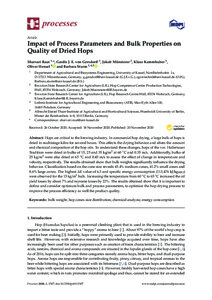Datum
2020-11-20Autor
Raut, Sharvarivon Gersdorff, Gardis J. E.Münsterer, JakobKammhuber, KlausHensel, OliverSturm, BarbaraSchlagwort
570 Biowissenschaften, Biologie 600 Technik HopfenTrocknungSchüttdichteChemische AnalyseEnergieverbrauchQualitätMetadata
Zur Langanzeige
Aufsatz

Impact of Process Parameters and Bulk Properties on Quality of Dried Hops
Zusammenfassung
Hops are critical to the brewing industry. In commercial hop drying, a large bulk of hops is dried in multistage kilns for several hours. This affects the drying behavior and alters the amount and chemical composition of the hop oils. To understand these changes, hops of the var. Hallertauer Tradition were dried in bulks of 15, 25 and 35 kg/m² at 60 °C and 0.35 m/s. Additionally, bulks of 25 kg/m² were also dried at 65 °C and 0.45 m/s to assess the effect of change in temperature and velocity, respectively. The results obtained show that bulk weights significantly influence the drying behavior. Classification based on the cone size reveals 45.4% medium cones, 41.2% small cones and 8.6% large cones. The highest ΔE value of 6.3 and specific energy consumption (113,476 kJ/kgH2O) were observed for the 15 kg/m² bulk. Increasing the temperature from 60 °C to 65 °C increased the oil yield losses by about 7% and myrcene losses by 22%. The results obtained show that it is important to define and consider optimum bulk and process parameters, to optimize the hop drying process to improve the process efficiency as well the product quality.
Zitierform
In: Processes Volume 8 / Issue 11 (2020-11-20) EISSN 2227-9717Förderhinweis
Gefördert durch den Publikationsfonds der Universität KasselZitieren
@article{doi:10.17170/kobra-202012222889,
author={Raut, Sharvari and von Gersdorff, Gardis J. E. and Münsterer, Jakob and Kammhuber, Klaus and Hensel, Oliver and Sturm, Barbara},
title={Impact of Process Parameters and Bulk Properties on Quality of Dried Hops},
journal={Processes},
year={2020}
}
0500 Oax
0501 Text $btxt$2rdacontent
0502 Computermedien $bc$2rdacarrier
1100 2020$n2020
1500 1/eng
2050 ##0##http://hdl.handle.net/123456789/12367
3000 Raut, Sharvari
3010 von Gersdorff, Gardis J. E.
3010 Münsterer, Jakob
3010 Kammhuber, Klaus
3010 Hensel, Oliver
3010 Sturm, Barbara
4000 Impact of Process Parameters and Bulk Properties on Quality of Dried Hops / Raut, Sharvari
4030
4060 Online-Ressource
4085 ##0##=u http://nbn-resolving.de/http://hdl.handle.net/123456789/12367=x R
4204 \$dAufsatz
4170
5550 {{Hopfen}}
5550 {{Trocknung}}
5550 {{Schüttdichte}}
5550 {{Chemische Analyse}}
5550 {{Energieverbrauch}}
5550 {{Qualität}}
7136 ##0##http://hdl.handle.net/123456789/12367
<resource xsi:schemaLocation="http://datacite.org/schema/kernel-2.2 http://schema.datacite.org/meta/kernel-2.2/metadata.xsd"> 2020-12-23T08:26:01Z 2020-12-23T08:26:01Z 2020-11-20 doi:10.17170/kobra-202012222889 http://hdl.handle.net/123456789/12367 Gefördert durch den Publikationsfonds der Universität Kassel eng Namensnennung 4.0 International http://creativecommons.org/licenses/by/4.0/ bulk weight hop cones size distribution chemical analysis energy consumption 570 600 Impact of Process Parameters and Bulk Properties on Quality of Dried Hops Aufsatz Hops are critical to the brewing industry. In commercial hop drying, a large bulk of hops is dried in multistage kilns for several hours. This affects the drying behavior and alters the amount and chemical composition of the hop oils. To understand these changes, hops of the var. Hallertauer Tradition were dried in bulks of 15, 25 and 35 kg/m² at 60 °C and 0.35 m/s. Additionally, bulks of 25 kg/m² were also dried at 65 °C and 0.45 m/s to assess the effect of change in temperature and velocity, respectively. The results obtained show that bulk weights significantly influence the drying behavior. Classification based on the cone size reveals 45.4% medium cones, 41.2% small cones and 8.6% large cones. The highest ΔE value of 6.3 and specific energy consumption (113,476 kJ/kgH2O) were observed for the 15 kg/m² bulk. Increasing the temperature from 60 °C to 65 °C increased the oil yield losses by about 7% and myrcene losses by 22%. The results obtained show that it is important to define and consider optimum bulk and process parameters, to optimize the hop drying process to improve the process efficiency as well the product quality. open access Raut, Sharvari von Gersdorff, Gardis J. E. Münsterer, Jakob Kammhuber, Klaus Hensel, Oliver Sturm, Barbara doi:10.3390/pr8111507 Hopfen Trocknung Schüttdichte Chemische Analyse Energieverbrauch Qualität publishedVersion EISSN 2227-9717 Issue 11 Processes Volume 8 false 1507 </resource>
Die folgenden Lizenzbestimmungen sind mit dieser Ressource verbunden:


